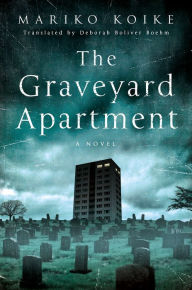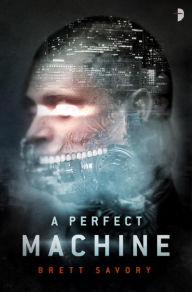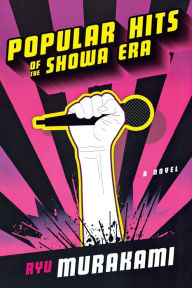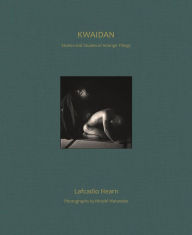8 Truly Terrifying Books of Asian Horror
 This week, HBO debuts Folklore, an anthology series focusing solely on Asian horror. And while it feels reductive to lump so many different cultures under a single classifying term, there is something markably different about these distinctly non-Western tales. The way they incorporate lingering atmosphere and building tension; the long, eerie stretches of silence; the sudden bursts of visceral violence and explosive supernatural activity; the intense focus on cerebral themes: the psychological, the existential, the twisted interior landscapes of its characters. The varied field of Asian horror has had a profound effect on Western writers as well, especially over the past two decades, where its influences can be plainly seen in both literature and film), and it continues to be an enduring and unsettling subset of dark fiction.
This week, HBO debuts Folklore, an anthology series focusing solely on Asian horror. And while it feels reductive to lump so many different cultures under a single classifying term, there is something markably different about these distinctly non-Western tales. The way they incorporate lingering atmosphere and building tension; the long, eerie stretches of silence; the sudden bursts of visceral violence and explosive supernatural activity; the intense focus on cerebral themes: the psychological, the existential, the twisted interior landscapes of its characters. The varied field of Asian horror has had a profound effect on Western writers as well, especially over the past two decades, where its influences can be plainly seen in both literature and film), and it continues to be an enduring and unsettling subset of dark fiction.
If Folklore has given you an appetite for more of these types of tales, we’ve selected eight of our favorites—both by Asian authors and by Western writers influenced by them—below.
Gyo (2-in-1 Deluxe Edition)
Gyo (2-in-1 Deluxe Edition)
By Junji Ito
In Stock Online
Hardcover $25.00
Gyo, by Junji Ito
In this classic work of Japanese horror manga, Ito demonstrates his flair for body horror and existential terror in an apocalyptic tale of mystery and mad science. Dead fish begin washing ashore, connected to odd mechanical legs that allow them to “walk.” At first a curiosity, the fish gradually become more of a problem as larger sea life wanders on to land, infecting humans with a gas-virus and eventually threatening to overrun the land entirely. It’d be weird to describe any of Ito’s work as “grounded,” but compared such macabre books as Uzumaki (about a supernatural curse that manifest via the appearance of spirals around a city) Gyo is even wilder, with such horrifying set pieces as a chase sequence featuring a land-shark and an infected octopus. There’s also a macabre “circus” where the infected perform tricks at the behest of a deranged ringmaster. While bizarre visuals may be the order of the day, the story is a deeper exploration of human impact on ecology and the lingering karmic debt of a country’s misdeeds, potent themes rendered in Ito’s painstakingly detailed black-and-white illustrations.
Gyo, by Junji Ito
In this classic work of Japanese horror manga, Ito demonstrates his flair for body horror and existential terror in an apocalyptic tale of mystery and mad science. Dead fish begin washing ashore, connected to odd mechanical legs that allow them to “walk.” At first a curiosity, the fish gradually become more of a problem as larger sea life wanders on to land, infecting humans with a gas-virus and eventually threatening to overrun the land entirely. It’d be weird to describe any of Ito’s work as “grounded,” but compared such macabre books as Uzumaki (about a supernatural curse that manifest via the appearance of spirals around a city) Gyo is even wilder, with such horrifying set pieces as a chase sequence featuring a land-shark and an infected octopus. There’s also a macabre “circus” where the infected perform tricks at the behest of a deranged ringmaster. While bizarre visuals may be the order of the day, the story is a deeper exploration of human impact on ecology and the lingering karmic debt of a country’s misdeeds, potent themes rendered in Ito’s painstakingly detailed black-and-white illustrations.
The Graveyard Apartment
The Graveyard Apartment
By Mariko Koike
In Stock Online
Hardcover $34.99
The Graveyard Apartment, by Mariko Koike, translated by Deborah Boliver Boehm
Blending an eerie locale—an obviously haunted apartment building crouching next to a graveyard—with the very idea of hunting for the ideal place to live, Koike’s novel begins with the death of the Kano family’s pet finch, just the first sinister act of a supernatural presence lurking in their building’s basement and growing in power. The building’s residents weigh their options: moving out of their choice apartment complex and finding other housing, or sticking with their comfortable digs despite the presence of a malevolent supernatural terror that keeps disappearing utility workers. Amplifying the atmosphere of unease are the dark secrets harbored by the Kanos themselves, which add another layer of intrigue and complexity to the plot. While some elements of the plot seem too far-fetched even within the confines of the odd premise, the creeping dread and the ties to grounded, modern concerns make this a fascinating, unnerving work.
The Graveyard Apartment, by Mariko Koike, translated by Deborah Boliver Boehm
Blending an eerie locale—an obviously haunted apartment building crouching next to a graveyard—with the very idea of hunting for the ideal place to live, Koike’s novel begins with the death of the Kano family’s pet finch, just the first sinister act of a supernatural presence lurking in their building’s basement and growing in power. The building’s residents weigh their options: moving out of their choice apartment complex and finding other housing, or sticking with their comfortable digs despite the presence of a malevolent supernatural terror that keeps disappearing utility workers. Amplifying the atmosphere of unease are the dark secrets harbored by the Kanos themselves, which add another layer of intrigue and complexity to the plot. While some elements of the plot seem too far-fetched even within the confines of the odd premise, the creeping dread and the ties to grounded, modern concerns make this a fascinating, unnerving work.
A Perfect Machine
A Perfect Machine
By Brett Savory
Paperback $7.99
A Perfect Machine, by Brett Savory
Taking numerous visual cues from Japanese cyberpunk films (particularly the Tetsuo trilogy), this breakneck thriller depicts the lives of the “runners,” a cult of seemingly immortal people chased through Toronto by their gun-toting “hunter” handlers in the hopes of getting shot up enough for their bodies to reach vaunted “100 percent metal content.” But as one of the runners gets close to his goal, his body begins to change in unexpected ways, triggering a different sort of chase through the city—a race to stop his terrifying transformation before it reaches its final phase. Savory’s slick prose is relentless, and the weird body horror and the plot’s weirder mysteries only help to strengthen the book’s surreal effect. While the unsettling transformations and unusual worldbuilding might not be for everyone, A Perfect Machine is entirely fearless in its commitment to going way too far, and that’s what makes it stand out.
A Perfect Machine, by Brett Savory
Taking numerous visual cues from Japanese cyberpunk films (particularly the Tetsuo trilogy), this breakneck thriller depicts the lives of the “runners,” a cult of seemingly immortal people chased through Toronto by their gun-toting “hunter” handlers in the hopes of getting shot up enough for their bodies to reach vaunted “100 percent metal content.” But as one of the runners gets close to his goal, his body begins to change in unexpected ways, triggering a different sort of chase through the city—a race to stop his terrifying transformation before it reaches its final phase. Savory’s slick prose is relentless, and the weird body horror and the plot’s weirder mysteries only help to strengthen the book’s surreal effect. While the unsettling transformations and unusual worldbuilding might not be for everyone, A Perfect Machine is entirely fearless in its commitment to going way too far, and that’s what makes it stand out.
Popular Hits of the Showa Era
Popular Hits of the Showa Era
By
Ryu Murakami
Translator
Ralph McCarthy
In Stock Online
Paperback $14.99
Popular Hits of the Showa Era, by Ryu Murakami, translated by Ralph McCarthy
Popular Hits of the Showa Era skews more towards dark horror-comedy than outright horror, but as with all of Ryu Murakami’s works (which also include Audition and In The Miso Soup), there’s a sense of the absurd that makes everything that happens all the more terrifying. After a sociopathic young college student decides to murder an old woman, her surviving friends (who call themselves “aunties”) get together to dole out vigilante justice on the man and his group of friends. This cycle of revenge quickly spirals out of control, becoming more twisted and dangerous as the two opposing sides plot out ever more obtuse and bloody schemes during their nightly karaoke parties. While all this is going on, numerous bystanders, hangers-on, ghosts, and other equally weird characters are pulled into the orbit of the war between the young men and old women. While the main appeal is seeing exactly how insane the conflict will get, and goggling at the horror it derives from putting everyday people into a situation out of a bloody Warner Bros. cartoon, this one manages to swerve back and forth across the line between horrifying and hilarious so many times that you won’t be able to put it down until you reach the explosive, apocalyptic, completely over-the-top finale.
Popular Hits of the Showa Era, by Ryu Murakami, translated by Ralph McCarthy
Popular Hits of the Showa Era skews more towards dark horror-comedy than outright horror, but as with all of Ryu Murakami’s works (which also include Audition and In The Miso Soup), there’s a sense of the absurd that makes everything that happens all the more terrifying. After a sociopathic young college student decides to murder an old woman, her surviving friends (who call themselves “aunties”) get together to dole out vigilante justice on the man and his group of friends. This cycle of revenge quickly spirals out of control, becoming more twisted and dangerous as the two opposing sides plot out ever more obtuse and bloody schemes during their nightly karaoke parties. While all this is going on, numerous bystanders, hangers-on, ghosts, and other equally weird characters are pulled into the orbit of the war between the young men and old women. While the main appeal is seeing exactly how insane the conflict will get, and goggling at the horror it derives from putting everyday people into a situation out of a bloody Warner Bros. cartoon, this one manages to swerve back and forth across the line between horrifying and hilarious so many times that you won’t be able to put it down until you reach the explosive, apocalyptic, completely over-the-top finale.
The Hole: A Novel
The Hole: A Novel
By
Hye-young Pyun
Translator
Sora Kim-Russell
In Stock Online
Paperback $16.99
The Hole, by Hye-Young Pyun, translated by Sora Kim-Russell
Pyun has a way of turning situations as simple as a doctor’s office visit into scenes of surreal existential horror, and The Hole is a masterpiece of the form. After a car accident leaves Oghi disfigured and paralyzed and kills his wife, he is released into the custody of his mother-in-law (his sole living relative) and left in his bedroom to slowly recover. But in her grief, there’s something… off about Oghi’s mother-in-law, especially the way she digs up his wife’s painstakingly maintained garden into a series of large and ever-larger holes. This odd behavior only reveals more dark events in the lives of both Oghi and his mother-in-law: a history of abusive neglect and disturbing actions. Pyun makes Oghi’s situation feel stiflingly claustrophobic from page one, the feeling of helplessness made palpable by a narrator unable to do anything but describe what’s happening to his body in horrid detail.
The Hole, by Hye-Young Pyun, translated by Sora Kim-Russell
Pyun has a way of turning situations as simple as a doctor’s office visit into scenes of surreal existential horror, and The Hole is a masterpiece of the form. After a car accident leaves Oghi disfigured and paralyzed and kills his wife, he is released into the custody of his mother-in-law (his sole living relative) and left in his bedroom to slowly recover. But in her grief, there’s something… off about Oghi’s mother-in-law, especially the way she digs up his wife’s painstakingly maintained garden into a series of large and ever-larger holes. This odd behavior only reveals more dark events in the lives of both Oghi and his mother-in-law: a history of abusive neglect and disturbing actions. Pyun makes Oghi’s situation feel stiflingly claustrophobic from page one, the feeling of helplessness made palpable by a narrator unable to do anything but describe what’s happening to his body in horrid detail.
The Day the Sun Died
The Day the Sun Died
By
Yan Lianke
Translator
Carlos Rojas
In Stock Online
Hardcover $26.00
The Day the Sun Died, by Yan Lianke
In a small village, a young boy notices that his neighbors are wandering around and carrying out their waking routines at night instead of going to bed. While this is curious and mildly disturbing at first, it soon becomes clear the villagers are trapped in a series of waking dreams, acting out their inhibitions and desires as their dream-states become more surreal and they vanish deeper into their subconscious. What follows is a nightmarish, occasionally offbeat novel, as Li Niannian and his family must find some way to get the sun to rise and stop the madness as the dreams become more unsettling—never mind that the family’s funeral business is suddenly booming as the dreamers turn on each other in chaotic ways. It’s a sharp satire of repression and a culture that clashes with the will of the people living within it.
The Day the Sun Died, by Yan Lianke
In a small village, a young boy notices that his neighbors are wandering around and carrying out their waking routines at night instead of going to bed. While this is curious and mildly disturbing at first, it soon becomes clear the villagers are trapped in a series of waking dreams, acting out their inhibitions and desires as their dream-states become more surreal and they vanish deeper into their subconscious. What follows is a nightmarish, occasionally offbeat novel, as Li Niannian and his family must find some way to get the sun to rise and stop the madness as the dreams become more unsettling—never mind that the family’s funeral business is suddenly booming as the dreamers turn on each other in chaotic ways. It’s a sharp satire of repression and a culture that clashes with the will of the people living within it.
The Girl with Ghost Eyes: The Daoshi Chronicles, Book One
The Girl with Ghost Eyes: The Daoshi Chronicles, Book One
In Stock Online
Paperback $7.99
The Girl with Ghost Eyes, by M.H. Boroson
Setting itself in 19th century Chinatown, Boroson’s tale of warring Taoist sorcerers, gruesome monsters, exorcism, and gangsters borrows as much from Hong Kong action films as it does Chinese mythology and monsters. But the author’s clear love of the material and reverence to the systems, magic, and culture helps elevate the story beyond the tropes, and adds depth and color to the martial arts-flavored fantasy. The story follows Li-lin, a pariah twice over in Chinatown, both for being a widow and for her strange “yin eyes,” able to glimpse he spirit world. When her father is attacked and left comatose by an evil sorcerer with horrifying plans for Chinatown and the world as a whole, Li-lin must take up the peachwood sword and talismans of her family’s trade and defend her father and her town. The action is kinetic, the fight scenes are slick, and the ending involves an absolutely terrifying running battle through the streets of San Francisco. With the sequel coming out near the end of the year, it’s a good time to experience the first Daoshi adventure.
The Girl with Ghost Eyes, by M.H. Boroson
Setting itself in 19th century Chinatown, Boroson’s tale of warring Taoist sorcerers, gruesome monsters, exorcism, and gangsters borrows as much from Hong Kong action films as it does Chinese mythology and monsters. But the author’s clear love of the material and reverence to the systems, magic, and culture helps elevate the story beyond the tropes, and adds depth and color to the martial arts-flavored fantasy. The story follows Li-lin, a pariah twice over in Chinatown, both for being a widow and for her strange “yin eyes,” able to glimpse he spirit world. When her father is attacked and left comatose by an evil sorcerer with horrifying plans for Chinatown and the world as a whole, Li-lin must take up the peachwood sword and talismans of her family’s trade and defend her father and her town. The action is kinetic, the fight scenes are slick, and the ending involves an absolutely terrifying running battle through the streets of San Francisco. With the sequel coming out near the end of the year, it’s a good time to experience the first Daoshi adventure.
Kwaidan: Stories and Studies of Strange Things
Kwaidan: Stories and Studies of Strange Things
By
Lafcadio Hearn
,
Hiroshi Watanabe
Introduction
Paul Murray
In Stock Online
Hardcover $35.00
Kwaidan, by Lafcadio Hearn
A journalist by trade, Hearn is probably most known for his writings about Japan, a place he had some fondness for and lived in for over a decade. While he was an accomplished cultural writer (though very much a product of his time and a little prone to exoticism), his best-known mainstream work is this collection of Japanese horror stories translated into English from older texts and stories he was told, along with his own anthropological notes on superstitions, and a recollection of something that happened to him in his youth. Hearn’s “strange stories” do a good job of preserving the tone and distinctly Japanese flavor of the works, enough so that the book has endured into the modern day and was influential to the point of even getting its own film adaptation. It’s a good jumping-off point for both fans of Asian horror and mythology in general, even if, again, it’s a product of a different era.
Kwaidan, by Lafcadio Hearn
A journalist by trade, Hearn is probably most known for his writings about Japan, a place he had some fondness for and lived in for over a decade. While he was an accomplished cultural writer (though very much a product of his time and a little prone to exoticism), his best-known mainstream work is this collection of Japanese horror stories translated into English from older texts and stories he was told, along with his own anthropological notes on superstitions, and a recollection of something that happened to him in his youth. Hearn’s “strange stories” do a good job of preserving the tone and distinctly Japanese flavor of the works, enough so that the book has endured into the modern day and was influential to the point of even getting its own film adaptation. It’s a good jumping-off point for both fans of Asian horror and mythology in general, even if, again, it’s a product of a different era.
What Asian horror titles would you recommend?







